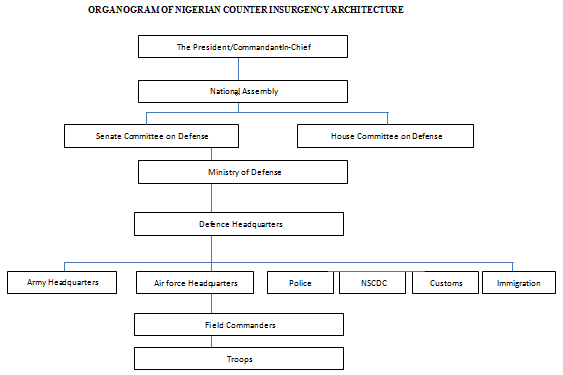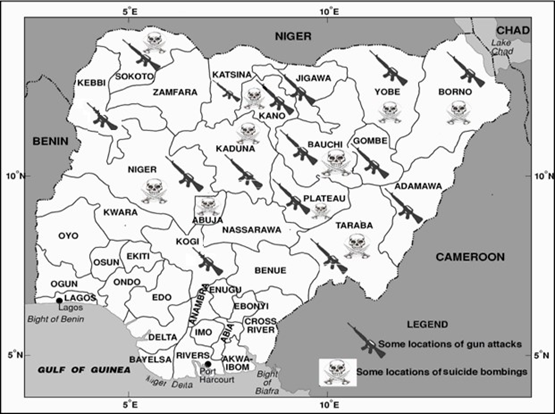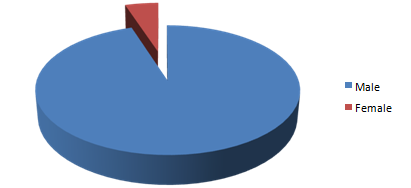INSURGENCY AND COUNTER INSURGENCY IN WEST AFRICA A CRITICAL ASSESSMENT OF FEDERAL GOVERNMENT RESPONSE TO THE BOKO HARAM INSURGENCY IN NIGERIA (2009 – 2013)
ABSTRACT
The insurgency has come to assume global concern in view of its magnitude and spread. In Nigeria, while history reveals that insurgency is not entirely new as the nation witnessed the Maitasine and Niger Delta insurgencies among others in times past, the wave of violence unleashed by the Boko Haram sect in northern Nigeria has proved unprecedented and has also revealed the extent of the failure of governance in the country, the abysmally poor crisis management tradition by the Nigerian state and its palpable inability to provide security to its citizens.
It has also brought to the fore the necessity on the part of the government to make concerted and intensified efforts to evolve lasting solutions to the intractable crisis in the country. This work is, therefore, an effort to assess the Federal Government of Nigeria’s response to the Boko Haram insurgency… (Scroll down for the link to get the Complete Chapter One to Five Project Material)

INTRODUCTION
Background of the Study
It is a historical fact that human society from time immemorial has been characterized by violence in various forms. In traditional societies, violence existed in the form of raids, tribal wars, slavery, and insurgency among others. These were conducted as individuals and groups sought to enhance their power, status, and influence over others or to register their grievances. The insurgency has existed throughout history but ebbed and flowed in strategic significance. Today the world has entered another period when the insurgency is common and strategically significant.
Insurgency is a strategy used by groups that cannot realize their political aims through conventional means of seizure of power. Insurgency is characterized by continued, asymmetric violence, ambiguity, the use of complex terrain (jungles, mountains, and urban areas), psychological warfare, and political mobilization which are designed to protect the insurgents and eventually affect the balance of power in their favor.
Insurgents may attempt to capture the power and replace the existing government (revolutionary insurgency) or they may have more limited objectives such as separation, independence, or alteration of a specific policy. They avoid battle places where they are weakest and focus on those areas where they can operate on more equal footing. They try to postpone decisive action, avoid defeat, sustain themselves, expand their support, and hope that, over time, the power balance changes in their favor (Metz, 2004: 2)… (Scroll down for the link to get the Complete Chapter One to Five Project Material)
Statement of the Research Problem
Violence is endemic in human society. However, the state exists to manage violence and thereby maintain order in society. The essence of the state thus lies in its ability to facilitate human interaction. Whether one is speaking of interpersonal relations or group dynamics, it is hardly contestable that the state plays a critical role… (Scroll down for the link to get the Complete Chapter One to Five Project Material)
Research Objectives
The under-listed will be the objectives of this study:
- To identify and discuss the major issues leading to the outbreak of the Boko Haram insurgency in Northern Nigeria.
- To examine the Nigerian state‘s response to the Boko Haram insurgency with a view to determining its efficacy and suitability… (Scroll down for the link to get the Complete Chapter One to Five Project Material)

LITERATURE REVIEW AND THEORETICAL FRAMEWORK
Literature Review
The previous chapter gave an introduction to the study and stated the research problem and objectives. This chapter comprises a review of the literature and theoretical framework. It is presented in a thematic manner with a focus on states’ responses to an insurgency within their borders. It examines some African countries‘ response to insurgency like Mali, Sudan, Sierra- Leone, Algeria, and finally Nigerian state‘s response to insurgency beginning with the Maitasine crisis of the 1980s, the Niger Delta insurgency and then the Boko Haram insurgency.
- Insurgency
An insurgency is simply an armed revolution against the established political order. Insurgencies are internal affairs and the insurgents are self-sustaining. They usually do not require assistance from foreign powers (Gen, 1976). Although insurgencies are civil wars, the situation becomes less clear-cut when outside powers intervene in some manner.
Often such intervention is only in the form of supplying arms aid to one side or the other or providing professional revolutionaries (like the Cuban revolutionary Ernesto Che Guevara in Bolivia) who can organize and discipline what might otherwise be a haphazard affair easily crushed by the government in power. When intervention draws the attention of an opposing power, an insurgency can quickly be cast as a major power confrontation (Gen, 1976)… (Scroll down for the link to get the Complete Chapter One to Five Project Material)
- Political Infrastructure
Although the military aspect of the struggle may ebb and flow, the source of insurgent strength; a covert political infrastructure remains constant. This infrastructure, the bitter fruit resulting from the perceived political and economic inequities sown much earlier, is the most important ingredient in the insurgent recipe for success (Summers, 1981).
The political infrastructure performs at least six major functions vital to the survival, growth, and eventual success of the insurgency: (1) intelligence gathering and transmission; (2) provision of supplies and financial resources; (3) recruitment; (4) political expansion and penetration; (5) sabotage, terrorism, and intimidation; and (6) establishment of a shadow government (Summers, 1981)… (Scroll down for the link to get the Complete Chapter One to Five Project Material)
Theoretical Framework
The postulations in this dissertation shall be founded upon the weak state theory. This approach is presented by Holsti (1993), Ake (1967), Buzan (undated), and Collins (2007). Deducing from Barry Buzan (undated), states comprise of three things: The institutional expression of the state (the bureaucracy), the idea of the state (the nation), and the physical base of the state (territory).
He asserted that weak states are those states where the idea and the bureaucracy are lacking leaving us with an ungoverned space whose territorial integrity is nonetheless enforced by international norms enshrined in the United Nations Charter.
The theory operates from the perspective of the rulers of the weak states. By analyzing actions in the context of the weak state, we see the context under which decisions are made and provide policy implications that affect the context and mitigate the costs of these contexts.
In weaker states, the nature of government and its relationship to other actors means that the survival of the regime becomes practically indistinguishable from the survival of the state…. (Scroll down for the link to get the Complete Chapter One to Five Project Material)
The Evolution of Insurgency in Nigeria
- History of Insurgency in Nigeria
There have been insurgent movements that characterized Nigeria‘s socio-political history. While there were several uprisings in times past the Niger Delta insurgency of the 1960s is a case in point.
The neglect, marginalization, and underdevelopment that generated activism and fomented unrest in the Niger Delta began during the colonial administration. Indeed, the recent events defined by oil politics constitute merely the tipping point in a conflict dating back to the colonial era. Thus, conflicts in the Delta can be categorized as pre- and post-oil conflicts, with different strands of engagement characterizing the post-oil conflicts… (Scroll down for the link to get the Complete Chapter One to Five Project Material)
- Military Task Forces and Counter-Insurgency in Nigeria
The police which is the primary institution responsible for internal security in Nigeria has been overwhelmed by the rising wave of insurgency largely because they lack requisite training and expertise in counter-insurgency operations (Francis et al. 2011)… (Scroll down for the link to get the Complete Chapter One to Five Project Material)
ORGANOGRAM OF NIGERIAN COUNTER INSURGENCY ARCHITECTURE

- Modus Operandi of the Boko Haram Sect
The activities of the Boko Haram sect in northern Nigeria have been different when compared with other groups. The sect operates in a similar way as the Somali Al- Shabaab in the Maghreb region of the Sahel and Al-Qaeda (Opukri and Etekpe, 2013). Attacks of this nature are usually swift, tempestuous, and enhanced by guerilla firepower. They usually target those they view as infidels or opponents of Sharia code that they supposedly seek to achieve. The Boko Haram has applied tactics and the common noes include the following:
- Bombing: This relies on the use of Improvised Explosive Devices (EIDs). This is the most prevalent strategy adopted by the sect. Typically the EIDs are easy to manufacture, they are smaller and hard to detect but contain very destructive capabilities. It has been pointed out by Opukri and Etekpe (2013) that in 2011 alone the sect carried out forty (40) bombings in northern Nigeria… (Scroll down for the link to get the Complete Chapter One to Five Project Material)
Figure 3.1: Locations of Boko Haram’s attacks and suicide bombings in Nigeria

Source: Onuoha, 2014 p.172
Since mid-2010 the sect‘s modus operandi has changed and they have become unpredictable. Old methods such as the targeted killing of the traditional ward and village heads, security officials, prominent politicians, and opposing ulama have continued unabated… (Scroll down for the link to get the Complete Chapter One to Five Project Material)

RESEARCH METHODOLOGY
Research Sites
This study was carried out in five (5) northern states. These, as well as the towns visited, are itemized in Table 3.1 below.
Table 3.1: Research Sites
| State | Towns Visited | |
| 1 | Kaduna | Kaduna, Jaji , Zaria |
| 2 | Kano | Kano Municipal Area |
| 3 | Bauchi | Bauchi Metropolitan Area |
| 4 | Yobe | Damaruru and Potiskum |
| 5 | Borno | Maiduguri Metropolitan Area |
Source: Author‘s Compilation
These states, as well as the towns visited, were chosen mainly because the spate of terrorist attacks by the Boko Haram sect took place in these areas.
Sample and Sampling Technique
A sample can be defined as a subset of a population that is selected to meet specific objectives (Essan and Okafor in Olayiwola, 2007). Gay (1980) describes sampling as the process of selecting a number of individuals for a study in such a way that the individuals represent the larger group from which they were selected… (Scroll down for the link to get the Complete Chapter One to Five Project Material)
RESEARCH FINDINGS AND DISCUSSION
Presentation and Analysis of Data
This section presents the opinions of the generality of Nigerians as sampled from questionnaires and structured interviews.
Fig. 5.1 Sex of Respondents

The information presented above shows a wide gap between male and female respondents. This may be explained by the nature of the topic which is sensitive and capable of instilling fear and suspicion, hence the females may not be bold enough to speak out. It may further be explained by the fact that the places visited have more males in the public sphere than females… (Scroll down for the link to get the Complete Chapter One to Five Project Material)
Discussion
Though Uwazie et al (1999) described the Maitasine riots as the most militant and widespread religious protest against the secular and religious establishment in Nigeria since independence, this description now befits the Boko Haram insurgency for more than the Maitasine uprisings of the 1980s.
Government approach to religious uprisings in times past can be viewed in the context of long or short term responses. The long term response is largely preventive (Uwazie et al, 1999). This is in so far as the responses come by way of specific and deliberate government policies aimed at establishing an enduring atmosphere of harmony and accord within the polity.
State policies can be steam lined into four perspectives i.e the ecumenical, the political/diplomatic, the constitutional and the security engineering perspectives (Uwazie et al, 1999)… (Scroll down for the link to get the Complete Chapter One to Five Project Material)
- Ignoring Early Warning Signs
It is a historical fact that religion plays a central and domineering role in Nigerian society (Usman, 1987). This has manifested as a potent variable in the socio-political development of Nigeria since the pre-independence era. In fact, a discussion of socio-political events in Nigeria would be incomplete without a discussion of religion… (Scroll down for the link to get the Complete Chapter One to Five Project Material)
CONCLUSION AND RECOMMENDATIONS
- Conclusion
The resurgence and escalation of the Boko Haram insurgency since early 2010 caught the Nigerian state unawares. It initially believed the violence would fizzle out.
However, sustained attacks ushered in more sober responses. Since 2012, it has tried to address the challenge on multiple tracks but especially by increasing the defense budget from a 100 billion naira in 2010 to 927 billions of naira in 2011 and 968 billions of naira in 2012, 2013 and over I trillion 2014. Much of these increases were to combat Boko Haram… (Scroll down for the link to get the Complete Chapter One to Five Project Material)
- Recommendations
The following recommendations are therefore put forward as strategies to effectively deal with the Boko Haram insurgency.
- Enhanced knowledge of the recruitment dynamics that feed and sustain the group can lead to a more proactive counter-terrorism framework for the Nigerian state… (Scroll down for the link to get the Complete Chapter One to Five Project Material)

REFERENCES
Abdulkadir M (2013): Interview on the Nigerian State‘s Handling of the Boko Haram Crisis, held on 16, July, at the News Room of the Headquarters of the Nigerian Television Authority (NTA), Area 11, Garki, Abuja.
Abdulkadir, M (2013): ―Duty Tour Of Chief of Defence Staff to Maiduguri‖ NTA News at 9, 12 July. Abimbola J.O and Adesote SA (2012): ―Domestic Terrorism and Boko Haram Insurgency in Nigeria, Journal of Arts and Contemporary Society; Vol.4 Cenresin Publications September.
Abimbola J.O and Adesote SA (2012): ―Domestic Terrorism and Boko Haram Insurgency in Nigeria,‖ Journal of Arts and Contemporary Society; Vol.4 Cenresin Publications September.
Abimbola, A (2010): ―The Boko Haram Uprising and Islamic Revivalism in Nigeria‖ in Africa Spectrum, German Institute of Global and Area Studies (GIGA), Institute of African Affairs in co-operation with the Dag Hammarskjold Foundation Uppsala and Hamburg University Press
Abubakar, A. (2009), ―Nigeria struggles to curb rise in child beggars‖, The Telegraph, 18
Abubakar, M (2009): ―Why the Fundamentalists Struck‖ The Guardian, August, 2. (Counter Insurgency)(Counter Insurgency)(Counter Insurgency)(Counter Insurgency)(Counter Insurgency)(Counter Insurgency)
Abubakar, S (2011): ―Borno Imbroglio: The Truth Behind the Lies‖, Daily Trust, July 26. (Counter Insurgency)(Counter Insurgency)(Counter Insurgency)(Counter Insurgency)(Counter Insurgency)(Counter Insurgency)
Abugu, F.O (2009): ―Boko Haram: Poverty, Not Islamists on the March‖, The Guardian, August 8. (Counter Insurgency)(Counter Insurgency)(Counter Insurgency)(Counter Insurgency)(Counter Insurgency)
Adejo, P.Y. (2005) ―Crime and Cross-Border Movement of Weapons: The Case of Nigeria‖ in A. Ayissi and I, Sall (eds), Combating the Proliferation of Small Arms and Light Weapons in West Africa: Handbook for the Training of Armed and Security Forces, Geneva: United Nations Institute of Disarmament Research (UNIDIR).
Adejuyigbe, O (1989) ―Identification and characteristics of Borderlands in Africa, In Asiwaju, AI and Adeniyi, PO (eds) (1989) Borderlands in Africa A multidisciplinary and Comparative Focus on Nigeria and West Africa, Lagos, University of Lagos Press. (Counter Insurgency)(Counter Insurgency)(Counter Insurgency)(Counter Insurgency)
Adeniyi, O (2011): Power, Politics and Death: A Front Row Account of Nigeria under Late President Yar‟Adua; Kachifo Press Limited, Lagos. (Counter Insurgency)(Counter Insurgency)(Counter Insurgency)(Counter Insurgency)
(Scroll down for the link to get the Complete Chapter One to Five Project Material)

